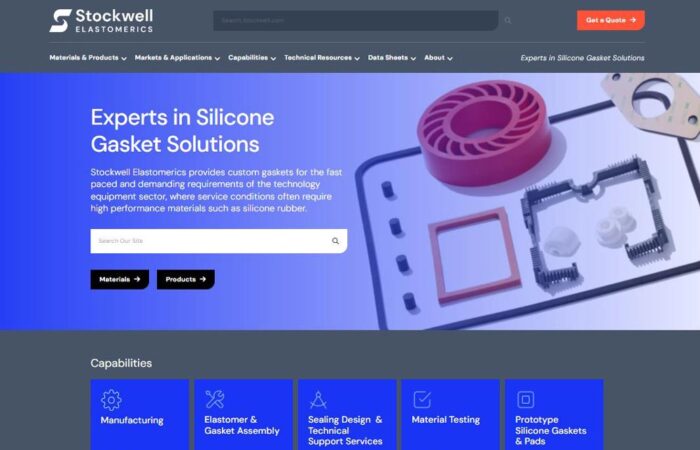Contact Stockwell Elastomerics
Request a quote or get more information.
Silicone (formally known as Polysiloxane) is a semi-inorganic polymer. It consists of siloxane polymers, or repeating chains of inorganic Silicon-Oxygen with organic groups (often methyl).
Silicone and silicon are often mixed up, but are quite different. They both start off the same – from Silicon dioxide, or quartz (SiO2). It is deoxidized to make elemental silicon, which is a metaloid used to make semi-conductors.
Siloxanes are elastomers. Silicone/Siloxane are made by taking pure silicon metal (from above), adding several other chemicals, and going through a complex chemical reaction. Based on the distillation process and molecular weight, products include silicone oil, caulk, grease, and silicone rubber.
Generally speaking, silicone is hydrophobic, water resistant, does not support microbial growth, chemically inert, ozone and UV resistant, electrically insulative, thermally insulative and stable across a wide range of temperatures.
Silicone is flexible because of the bonds in it’s backbone. That is, the angle between the silicon and oxygen (Si-O) can change very easily. The long, repeating chains of the polymer combined with that bond angle change is what makes the polymer so flexible.
The structure of closed cell sponge rubber has non-interconnecting, or individual cells that contain air – typically nitrogen gas. When deflected, the force applied to these cells causes the gas to be gradually squeezed through the thin cell membranes. When the deflecting force is released, the cells attempt to return to the original shape, drawing air back into the individual cells. Some sponge materials rebound quickly and some rebound very slowly or take a permanent deformation. Materials such as closed cell silicone sponge are more resilient and are better suited to rebound to close to the original sponge thickness. Deflection under high temperatures and severe deflection over 50% may damage the cell structure and impact the ability of the closed cell sponge to resist taking a permanent compression set. Open cell foams and sponges have cells that interconnect, allowing for air to pass through them quickly under deflection – and air is drawn back into open cell material faster when the deflection force is removed. Open cell foams and sponges are known for fast rebound, and generally return to original thickness. PORON® cellular urethane is an excellent example of open cell foam having excellent compression set resistance.
Both of these terms refer to compression phenomena of elastomers – they are ways of describing and measuring the unique way elastomers respond to compression forces.
Stress relaxation refers to the tendency of an elastomer to lose induced stress when held at a constant strain state. When an elastomer is compressed and held there, the “push back” force against the housing decreases over time. This is stress relaxation.
Compression set refers to the tendency of an elastomer to retain strain when compression stress is removed. After being compressed and “let go”, some elastomers will fail to return to their original thickness and will take a permanent “set”. This is often undesirable, so we often refer to material’s compression set resistance.
Many silicone rubber compounds utilize curing agents that require a secondary post-cure to finish the curing process. Although most silicones can pass the physical parameters of silicone specifications with a press cure at 300° to 340°F, the mechanical properties such as compression set resistance, can be enhanced using a 4 hour post-cure at 400°F in a hot air circulating oven. Most sheet silicone manufacturers post-cure to some extent. Further, if your application requires high temperature resistance, such as a door gasket on a high temperature chamber or oven, or high temperature testing instrument, an un-post-cured gasket may appear to smoke as it releases these trapped curing agents. These by-products are non-toxic; however they may be annoying to your customers!
From our experience, when PORON is deflected 35% or more, it can perform as a good enclosure gasket material for NEMA 4 wash downs and similar water spray applications. The edge of the gasket should be protected from direct high pressure spray, such as with an edge shield or lip on a door closure. We would not recommend PORON for submerged enclosures, or for applications where the gasket might be flexed under water, as the squeeze / release action will cause water absorption. The microcellular structure of PORON, having very small cell openings, helps to resist the wicking effect when gasket edges are in contact with water in static (versus dynamic) applications.
EPDM compounds often contain ingredients, such as paraffins, that bloom or migrate to the surface over time. When these additives migrate to the surface, an adhesive backing will likely be shed from the surface. Although this bloom effect often benefits the resistance of EPDM to sunlight, acids and other conditions – long term bonding is made difficult. Low durometer neoprene and Buna-N compounds often contain oils and plasticizers that make these surfaces difficult to bond to. An adhesive backing may appear to have acceptable anchoring onto the gasket surface in the immediate days following the lamination, only to have the adhesive separate due to the migration of oils and plasticizers. If your specification calls for one of these materials with an adhesive backing, the adhesive should only be counted on as a temporary assembly aide. Such gaskets supplied with adhesive backings must be applied immediately, and the design must include bolt holes such that mechanical fastening is the prime method of maintaining the position of the gasket in final assembly.
For answers to others questions or to request further clarification, Contact Us for further assistance.
Request a quote or get more information.

